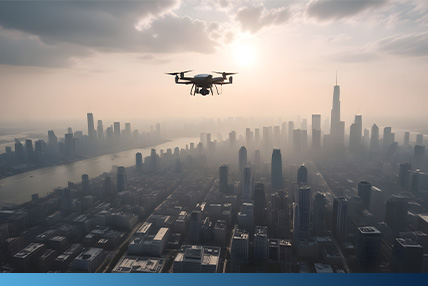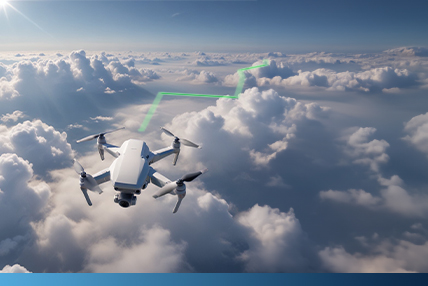A proven solution for drone tracking
Over the past fifteen years, the popularity and accessibility of UAS (Unmanned Aerial Systems) or Unmanned Aerial Vehicles (UAV), commonly known as drones, for commercial or recreational use have seriously surged threatening the security of critical infrastructures and the organization of events.
Drone Tracking: Main Challenges


Technology accessible by everybody
Drones have become ubiquitous in various sectors, from recreational use to critical industrial applications. As their prevalence grows, the need for effective drone tracking systems has become paramount. Ensuring airspace security and privacy relies on the ability to detect, monitor, and manage drone activities. However, this task is not without its challenges.
UAV, a fast and stealthy target
30cm x 30cm size of UAV is now a standard on the commercial drones available. Such size of drone offers limited RCS (Radar Cross Section) for a proper detection with traditional technology such as radar.Counter-UAV becomes even more challenging when operating in an urban area; offering a complex electromagnetic environment.
Fast angular speed of drones is also another difficulty in a context where the tracking will be essential in order to deliver a fast counter-reaction with the appropriate effector.
Pre-programmed drone flight
Counter-UAS technology such as RF (Radio Frequency) could not detect drone in somme specific case where there is no communication between the operator and the drone: typically in the case of a pre-programmed flight path.
Drone Tracking: Main Threats



Unmanned Combat Aerial Vehicle (UCAV)
Also known as combat drone, fighter drone or battlefield UAV, this type of UAV – with the dimension of small traditional aircraft – is rather used for intelligence, surveillance, target acquisition and reconnaissance mission.
Some drones are equipped with stealth technologies, such as radar-absorbing materials or anti-tracking measures, making them harder to detect by conventional tracking systems, especially in urban or cluttered environments.
Commercial drones
Drones often operate at low altitudes, exploiting their small size to evade detection. Tracking systems must overcome the difficulty of precisely identifying and following these small airborne objects.
These small drones are often used for different purposes such as illicit activities (smuggling, drug trafficking, espionage), terrorist threats, airspace invasion which could conclude to airport temporary shutdown.
Drone Swarms
The scalability of drone operations, particularly in swarm configurations, poses a challenge for detection and classifying a swarm of UAV and quickly activate effector to neutralize such threats.
Drone Tracking Solution
With Spynel Panoramic Infrared Cameras


HGH Infrared Systems has developed an innovative panoramic solution detecting and categorizing long-range threats. The SPYNEL infrared camera range protects any kind of critical infrastructures or military assets thanks to a 360° camera. Fully passive, the SPYNEL camera ensures real-time panoramic video and automatic detection, classification & tracking.
How to detect & track drones?

Why choosing Spynel for Counter-UAS?
With Spynel’s thermal imaging technology, it is impossible for a drone to go unnoticed: any object, hot or cold will be detected by the 360° thermal sensor, day and night. Working in tandem with the Cyclope intrusion detection software, Spynel tracks an unlimited number of targets (airborne, but also terrestrial or maritime threats) to ensure that no event is missed over a long-range, wide area surrounding. Basic classification of targets is based on elevation calibration and all air targets are represented by a dedicatedicon. Thermal imaging allows for day and night surveillance, but also guarantees the ability to view any object, even deemed as stealth, whether it is hot or cold.
360-Degree Coverage
SPYNEL's panoramic infrared camera offers complete 360-degree coverage, eliminating blind spots and ensuring a comprehensive view of the airspace for effective counter-UAV
Multi-Target Detection & Classification Capabilities
SPYNEL's advanced algorithms allow for precise multi-target detection & classification, enabling the simultaneous monitoring of multiple drones, crucial for managing scenarios involving multiple airborne threats.
Real-Time Surveillance and Rapid Response
The 360° camera facilitates real-time surveillance, giving situational awareness and allowing for immediate detection and tracking of drones. This capability enhances response times, enabling prompt and effective countermeasures in case of potential threats.
Remote Monitoring Capabilities
SPYNEL offers remote monitoring capabilities, allowing operators to observe and track drone activities from a centralized location. This feature enhances the safety of monitoring personnel and facilitates continuous, unobtrusive surveillance.
Adapted to Urban Environments (passive)
SPYNEL, as a fully passive solution, will not be disturbed by the complex electromagnetic environment in a city, unlike radar technology.SPYNEL is well-suited for detecting & tracking drones in various conditions, including adverse weather with clouds, providing reliability in diverse
Reduced False Alarms
Integration of advanced analytics minimizes false alarms, distinguishing between routine aerial activities and potential security threats, optimizing the efficiency of the drone tracking system.
Integration with Existing Systems
Seamless integration with existing drone tracking and air traffic management systems ensures compatibility and interoperability, creating a cohesive and interconnected infrastructure for enhanced overall operational effectiveness.
Tracking Versatility
SPYNEL's versatility allows it to track various types of drones, regardless of size or propulsion methods, providing a comprehensive solution for monitoring the evolving landscape of drone technologies.









